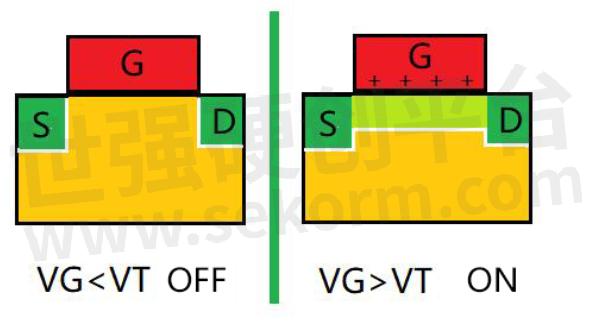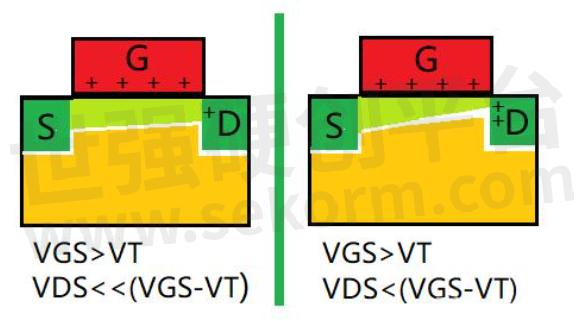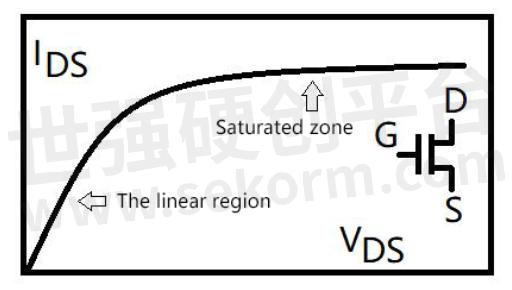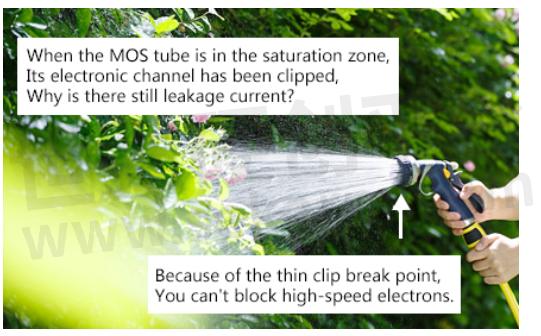The Popular Science, Why is the Channel Clipped in the Saturation Area of MOS Tube and the Current?

The MOS tube is like a switch; the gate (G) determines whether the source (S) to drain (D) is on or off.
Take NMOS as an example. In the figure below, green represents (N-type) electron-rich region and yellow represents (P-type) electron-rich hole region. At the p-n junction there is a depletion layer (also known as the space charge area, as shown in the white divider). VT is the threshold of the switch, above which it is on, below which it is not on. The greater the gate voltage, the more electrons are induced from below, and the wider the channel is formed. The gate is separated from the channel by an oxide layer. It is easy to understand that the channel width is the same when the source drain has no voltage.

Fig.1
The gate voltage generation channel determines whether the MOS tube source leakage flow between
When the drain voltage increases, the gate near the drain voltage relative voltage is small, so the channel affected by its width is different. Because the current is continuous, the current density is high in narrow areas, which is easy to understand, as shown in the figure below. This is the "linear region" in which source drain current IDS increases linearly as its voltage VDS increases.

Fig.2
Channel width and width are affected by voltage at both ends (linear region)
It should be noted that the absolute value of the gate voltage does not decrease at this time, and the reason for the narrowing of the channel near the drain is that the influence of the gate is partially offset by the drain. Some of the electrons that would have been attracted to the gate to form the channel were pulled by the drain positive voltage.
When the drain voltage continues to rise, if it exceeds the gate voltage, the right side of the channel will not meet the opening conditions and "clipping". The break point occurs because at this point the attraction of the gate to the electrons is replaced by the drain. At this time, the MOS tube enters the "saturation zone", the current is difficult to continue to increase with the voltage.
A lot of students can't understand since the ditch clip broke at this time, shouldn't it be over? Why does the current continue to flow?
The reason is that although the channel is theoretically "clipped", the clipping point is weak. Why is it weak? This is because behind the breakpoint it is supported not by the original P-shaped region, but by the drain and its space charge region, where the increased voltage attracts more electrons. So electrons rush into the space charge zone, where "quasi-free electrons" with little resistance are quickly collected by the drain. As shown in the figure below.

Fig.3 Channel "clamping and continuous" (saturation zone)
It can be imagined that as the channel near the drain gets thinner and thinner, a lot of high-speed electrons rush in, some of which squeeze through the break point and enter the space charge area, and then are collected at high speed by the drain positive electric field (purple current in the schematic diagram). The higher the drain voltage is, the more backward the break point is, and the more difficult it is for electrons to pass through. Therefore, the current in the saturation region no longer increases linearly with the increase of the voltage. After all, not all electrons can pass through the break point. The source leakage current voltage curve is shown in the figure below.

Fig.4 Current voltage curve
It is easy to understand with the water gun analogy: when the water flow in the pipe is very fast, it is difficult to block it with a thin sheet. The water will be exposed to the barrier and form a jet. The thinner the nozzle, the faster the jet, as shown in the figure below. So the word "clipping" is misleading. It's actually "clipping" and the current is limited rather than cut off.

Fig.5
The flakes have a hard time blocking the squirt
Of course, if the drain voltage continues to rise and its space charge area continues to expand to the source electrode, the electrons of the source electrode will directly pass through the space charge area and reach the drain electrode at high speed without being controlled by channel and gate voltage, which means that the source leakage will directly pass through, and then the switching function of THE MOS tube will be useless.
- +1 Like
- Add to Favorites
Recommend
- Details of MOS tube packaging
- The Differences between MOS Tube and IGBT Tube
- MOS Tube Drive Circuit Summary - Detailed Design of Various Switching Power Supply MOS Tube Drive Circuit
- Explain in Detail the Cause of MOS Tube Heating
- What is the Difference between MOS tube and IGBT?
- MOS Tube Knowledge, Must Read!
- How to Judge the Working State of MOS Tube?
- MOS Tube Anti-overvoltage Circuit
This document is provided by Sekorm Platform for VIP exclusive service. The copyright is owned by Sekorm. Without authorization, any medias, websites or individual are not allowed to reprint. When authorizing the reprint, the link of www.sekorm.com must be indicated.






























































































































































































































































































































































































































































































































































































































































































































































































































































































